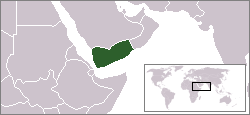| Revision as of 06:53, 17 February 2004 view sourceWetman (talk | contribs)Autopatrolled, Extended confirmed users, Pending changes reviewers, Rollbackers92,066 editsm deleted "Cradle of Humanity" spoof in first line← Previous edit | Revision as of 18:56, 19 February 2004 view source Hashar (talk | contribs)Extended confirmed users2,602 editsm HasharBot - robot Adding:fr,nl,de,eo,da,sv,jaNext edit → | ||
| Line 86: | Line 86: | ||
| <center>] | ]</center> | <center>] | ]</center> | ||
| ] | |||
| ] | |||
| ] | |||
| ] | |||
| ] | |||
| ] | |||
| ] | |||
Revision as of 18:56, 19 February 2004
The Republic of Yemen is a country in the Middle East, bordering the Arabian Sea, Gulf of Aden, and Red Sea, between Oman and Saudi Arabia.
| |||||
| National motto: Xxxxx | |||||
 | |||||
| Official language | Arabic | ||||
| Capital | Sanaá | ||||
| President | Ali Abdullah Saleh | ||||
| Area - Total - % water | Ranked 48th 527,970 km² Negligible | ||||
| Population
- Density | Ranked 53rd
37/km² | ||||
| Unification | May 22, 1990 | ||||
| Currency | Yemeni rial (YER) | ||||
| Time zone | UTC +3 | ||||
| National anthem | United Republic | ||||
| Internet TLD | .YE | ||||
| Calling Code | 967 | ||||
History
Main article: History of Yemen
North Yemen became independent of the Ottoman Empire in 1918. The British, who had set up a protectorate area around the southern port of Aden in the 19th century, withdrew in 1967 from what became South Yemen. Three years later, the southern government adopted a Marxist orientation. The massive exodus of hundreds of thousands of Yemenis from the south to the north contributed to two decades of hostility between the states. Egypt under Nasser aided the southern Marxist Yemen force militarily, including the use of chemical weapons, specifically mustard gas and perhaps an organophosphate nerve agent, against royalist troops in North Yemen. The two countries were formally unified as the Republic of Yemen in 1990. A southern secessionist movement in 1994 was quickly subdued.
Politics
Main article: Politics of Yemen
Governorates
Main article: Governorates of Yemen
Geography
Main article: Geography of Yemen
Economy
Main article: Economy of Yemen
Yemen, one of the poorest countries in the Arab world, reported strong growth in the mid-1990s with the onset of oil production, but was harmed by low oil prices in 1998. Yemen has embarked on an IMF-supported structural adjustment program designed to modernize and streamline the economy, which has led to foreign debt relief and restructuring. Aided by higher oil prices in 1999, Yemen worked to maintain tight control over spending and implement additional components of the IMF program. The high population growth rate of 3.4% and internal political dissension complicate the government's task.
Demographics
Main article: Demographics of Yemen
Culture
Main article: Culture of Yemen
| Date | English Name | Local Name | Remarks | |
|---|---|---|---|---|
| January 1 | New Year's Day | - | ||
| May 22 | Day of National Unity | - | Celebrates Unification of Yemen | |
| September 26 | Revolution Day 1963 | - | - | |
| October 14 | National Day | - | - | |
| November 30 | Independence Day | - | - | |
| - | Eid al-Adha | - | date varies | |
| - | Eid al-Fitr | - | date varies | |
| - | Muharram | - | date varies | |
| - | Lailat ul-Miraj | - | date varies | |
| - | Prophet's birthday | Mouloud | date varies |